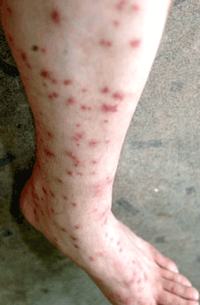Identification of fleas is important to help know what treatment methods to use.
They are known by their Latin name: Ctenocephalides Felis in the order of Siphonaptera.
Fleas Appearance
To start with proper identification of fleas let’s look at their appearance. These tiny parasitic insects appear reddish brown in color, and they grow to about 2.5mm. Their entire bodies are covered with compressed hair which helps them to burrow through their hosts fur, it can be seen with the aid of microscope.
Movement of Fleas
Fleas can jump seven inches into the air with their specialized limbs. Although they are wingless, fleas have strong hind legs with spring-like joints. This allows fleas to travel further.
How Flea Infestation Begins
Parasites need a host to survive. In order to do this, they attach themselves to any animal available. Fleas choose dogs and cats as host animals especially when they roam outside the house. Fully grown fleas looking for a fresh blood meal will jump on them; they will carry these insects into homes and begin the infestation. Once a flea enters a household, it is very difficult to get rid of especially when the species is not really clear. However, those with pets are not the only ones vulnerable to an infestation, any house overrun with rodents is likely to become infested too.
Fleas Search for a Host to Feed On

Adult fleas emerging from its protective pupae needs a fresh blood meal to survive and so will attack anybody or animal in sight. They will come out when they sense the presence of a mammal through an increase in carbon dioxide content in the air.
Another time a flea searches for a host to subsist on is when its off its original host and into furniture or bedding. Markedly, Fleas which sense that its rodent host is about to be removed from a household once it is trapped will leave it in search of another. The flea can possibly end up attaching themselves to the homeowner’s pets.
How Dangerous are Fleas?
In a statement by CDC, several diseases are transmitted through flea bites and the number has increased between 2004 and 2016. The bites are usually very itchy and painful more so for people who are allergic to the flea saliva and bites.
Fleas are tiny and almost not visible to the naked eyes, they also reproduce at a fast rate which makes it extremely difficult to get rid of them when they infest a house.
Signs of a Flea Ridden House
- Fecal matter: Fleas tend to leave dirt whenever they infest a home such as their feces which appear like ground black pepper. It can be seen in carpets, mattresses, cushions and rugs.
- Flea eggs: the only stage that can be seen easily around are the adult fleas, egg, larvae and pupae do not require a blood meal to survive so they remain at their hidden spots until adult stage. They are spread throughout the house when they fall off the adult’s bodies.
- Animals scratching: when pets are flea infested, they respond to the numerous bites by scratching themselves frequently especially when they lie on their sleeping areas.
- Bites on people: parasites that get dislodged from their host’s bodies and end up on carpets and mattresses where they bite humans in search of hosts and a blood meal. People experience frequent bites if a house is infested.
Feeding
At the larvae stage, all it needs to survive are debris, adult flea fecal matter and dirt. Pupae stays enclosed in a cocoon and does not feed.
They normally prefer to make various animals its host like mice, squirrel, cats, dogs, wild animals, rats, domestic animals etc.
Reproduction
Female fleas reproduce after taking fresh blood from their host. They lay eggs which fall off into cracks in the flooring, carpets, rugs, furniture, pet bedding even on bare ground. The laid eggs will hatch in two days.
How to Exterminate Fleas and Prevent Them from Infesting a Home
The easiest yet effective way to prevent flea infestation is by cleaning out the environment, getting rid of every flea habitat outdoors with the use of pesticides that can kill fleas. A professional should be contacted to handle the infestation.
Every hole and crack in a home should be sealed completely to prevent rodents that might be flea infested from entering the house. Pets should be groomed properly also to get rid of any parasite in its body.
Fleas carry diseases that they transmit to their hosts after feeding, various diseases like Murine typhus, cat scratch disease and bacterial infections.